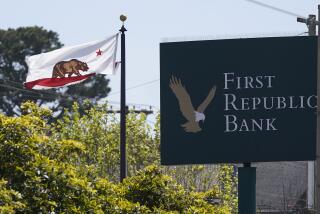Shoring Up the S
- Share via
President Bush appears to have come up with constructive proposals to reform the savings-and-loan industry and to take precautions against major new reverses among the banks. Now Congress, through hearings, must determine whether the proposals are as good as they look.
His plan is certainly an improvement over earlier talk of a direct tax on deposits. But he was the first to acknowledge that the new plan involves costs that would almost certainly be passed along to depositors. That probably would be a small price to pay for the security afforded by federal deposit insurance.
He intends action on three fronts: (1) a $90-billion bailout as the federal government protects depositors in the failed savings-and-loan institutions, with the federal government moving quickly to take over the weakest; (2) a reorganization of federal regulatory agencies, increased inspection and tighter regulation--including a doubling of mandatory capital in savings-and-loan institutions; (3) a $50-million increase in Justice Department funding to facilitate the hot pursuit of those who may have violated the law.
The savings-and-loan industry itself would bear close to half the estimated cost. Taxpayers would cover the other half, with a first-year budget of $1.9 billion. It will be for Congress to sort out the equity of that formula for burden-sharing. It may be significant that some in the industry had expected to pay more.
At the same time, the deposit-insurance rates for banks would also be increased as a preventive measure to build reserves of the Federal Deposit Insurance Corp., dangerously depleted by big bank failures. This, too, would be matched by tougher regulation to try to avoid more disasters. The bank funds would not be used to cover savings-and-loan rescue operations, which seems fair.
There are lingering doubts about the plan that may be resolved when more details become known. It is not clear whether the new supervision by the Treasury Department would be adequate to guarantee the President’s commitment that “the situation is not repeated again.” It was, nevertheless, reassuring that regulators are already implementaing takeovers of failing institutions. There is clearly a need for more and better inspection by the federal regulators, but there is no way at this stage to judge the adequacy of Bush’s plans in this area. Some experts are skeptical that the special $50-billion bond issue, and the $40-billion bailout contrived last year by the Reagan Administration, would be adequate. It will be important for Congress to look closely at the deals struck last year to sell off failing savings-and-loan institutions in exchange for modest new investments and tax concessions to be sure that those remedies did not serve merely to postpone the risk of yet another collapse in the years ahead.
In effect, Bush’s plan acknowledges an inexcusable and outrageous failure of business and government that now burdens everyone. He is right, of course, to affirm the obligation to make good on deposit insurance within the limits of the law. And he is right, also, to pursue those who apparently committed crimes. But it is important to remember that many of those responsible for the disaster were guilty of no felony. They were guilty of reckless management driven by greed, and complaisant supervision enamored of deregulation. And that atmosphere was encouraged at the highest levels of government. Bush appears intent on change. That would indeed be appropriate.
More to Read
Sign up for Essential California
The most important California stories and recommendations in your inbox every morning.
You may occasionally receive promotional content from the Los Angeles Times.













